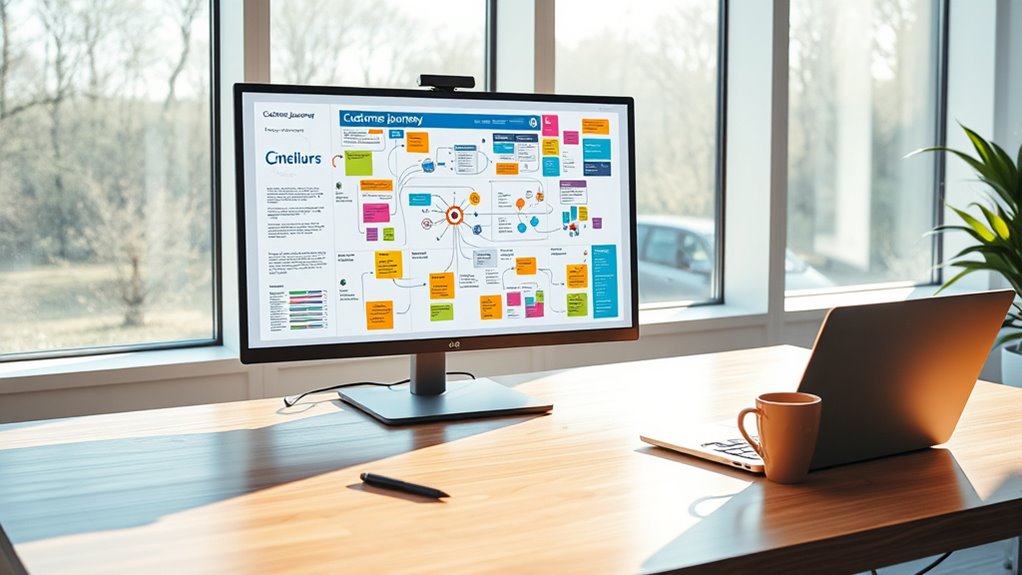Mapping the customer journey with Miro helps you visualize every interaction your customers have with your brand, revealing important touchpoints and insights. First, set up a dedicated workspace with organized sections for each stage of the journey. Use visual tools, icons, and templates to craft clear, engaging maps. Collaborate easily with team members and share your work for feedback. By analyzing these maps, you can identify pain points and improve the overall experience—continue exploring to learn more about optimizing your customer journey.
Key Takeaways
- Create a dedicated Miro board with templates and icons for organizing customer journey stages and touchpoints.
- Develop detailed customer personas to accurately map target segments and their interactions.
- Use visual tools, color coding, and icons to clearly illustrate journey phases and key touchpoints.
- Collaborate in real-time by sharing the map, enabling team input, comments, and updates for continuous improvement.
- Analyze customer feedback and data within Miro to identify pain points, optimize touchpoints, and enhance overall experience.
Understanding the Customer Journey and Its Importance

Understanding the customer journey is essential because it reveals how your customers interact with your brand at every touchpoint. By mapping this journey, you gain insights into customer needs at each stage, helping you tailor your approach more effectively. Touchpoint analysis allows you to identify where customers engage with your brand, whether through social media, website visits, or customer service. Recognizing these interactions helps you improve the overall experience, address pain points, and strengthen customer loyalty. When you understand the full journey, you can create targeted strategies that meet customer needs proactively. This clarity guarantees your marketing efforts resonate, making your brand more responsive and customer-centric. Ultimately, a well-mapped customer journey empowers you to deliver value at every step. Incorporating content analysis can further refine your understanding of customer interactions and preferences.
Setting Up Your Miro Workspace for Journey Mapping

To effectively create your customer journey map in Miro, start by setting up a dedicated workspace that organizes your visuals and collaboration tools. This workspace setup guarantees everything stays accessible and streamlined. First, create a new board specifically for journey mapping. Second, customize your tools by adding relevant templates and icons to speed up your process. Third, organize your workspace with clear sections for each customer touchpoint. Fourth, invite your team and set permission levels to facilitate collaboration. Tool customization is key—adjust colors, labels, and structures to match your project needs. A well-organized workspace helps you stay focused and efficient, making your customer journey mapping smoother and more effective. Additionally, understanding relationships dynamics can enhance your insights into customer interactions.
Designing Effective Customer Journey Maps in Miro

Once your workspace is set up, the next step is designing your customer journey map in Miro to maximize clarity and impact. Start with persona development to clearly define your target customer segments, ensuring your map reflects their needs and behaviors. Use Miro’s visual tools to map out each phase of the journey, highlighting key touchpoints where customers interact with your brand. Conduct touchpoint analysis to identify moments that influence customer satisfaction and loyalty. Keep your layout simple and logical, using color coding and icons to differentiate stages and touchpoints. Regularly update your map based on new insights. A well-designed journey map helps you see the customer experience holistically, guiding improvements and aligning your team’s efforts effectively. Incorporating essential oils for customer well-being concepts can also help create a calming and focused planning environment.
Collaborating and Sharing Your Journey Maps With Teams

Collaborating and sharing your customer journey maps in Miro is essential for aligning your team and driving improvements. It enables seamless collaborative brainstorming and enhances visual storytelling, making complex insights easier to understand. To maximize this, you can:
- Share your maps directly with team members via links or embedded boards.
- Invite real-time editing to encourage collaborative brainstorming sessions.
- Use comments and sticky notes for feedback and clarifications.
- Present the map in meetings to foster a shared understanding and facilitate discussion.
- Incorporate anime movies and animated films into presentations to create engaging and emotionally resonant storytelling.
Analyzing Insights and Implementing Improvements

Analyzing insights from your customer journey maps is crucial for identifying pain points and opportunities for improvement. You should review customer feedback carefully, looking for recurring issues or negative experiences that stand out. Using data visualization tools in Miro, you can turn raw data into clear, actionable visuals that highlight problem areas. This makes it easier to pinpoint where customers drop off or encounter friction. Once you understand these insights, you can prioritize changes and test new strategies. Implementing improvements based on this analysis helps enhance the overall customer experience and boosts satisfaction. Regularly updating your journey maps with fresh feedback and visual data ensures your team stays aligned and continuously optimizes the customer journey effectively.
Frequently Asked Questions
Can Miro Integrate With Other Customer Analysis Tools?
You’re wondering if Miro can integrate with other customer analysis tools. Yes, Miro offers a variety of integration options that enhance tool compatibility, making it easier for you to connect with popular platforms like Slack, Jira, or Salesforce. These integration options streamline your workflow, allowing seamless data sharing and collaboration. This means you can easily incorporate insights from your existing customer analysis tools directly into your Miro boards for a more all-encompassing view.
What Are Best Practices for Updating Journey Maps Over Time?
Ever think your journey map is set in stone? Think again. To keep it relevant, you should implement feedback loops and make iterative updates regularly. Review customer interactions, team insights, and data to identify changes. Schedule periodic check-ins and encourage collaboration. This way, your map evolves with your business, helping you stay aligned with customer needs—and avoid the irony of a static, outdated map in a dynamic world.
How Do I Customize Templates for Specific Industries?
You can easily customize templates for specific industries by focusing on industry-specific customization and template personalization. Start by selecting a template that closely aligns with your industry, then adapt it by adding relevant icons, colors, and terminology. Use Miro’s flexible tools to tailor the layout and content, ensuring it resonates with your industry’s unique needs. This approach makes your customer journey maps more relevant and impactful.
Is There a Way to Track Changes in the Customer Journey?
Did you know that 86% of buyers say they’re willing to pay more for better customer experience? Tracking changes in the customer journey is easy with data visualization tools like Miro. You can incorporate customer feedback at each stage, identify pain points, and update your journey map dynamically. This way, you stay responsive and continuously improve, ensuring your strategies align with actual customer needs and behaviors.
How Can I Ensure Stakeholder Engagement With the Maps?
To guarantee stakeholder engagement with your maps, you should foster stakeholder collaboration by involving them early and regularly. Share drafts frequently and encourage user feedback to make everyone feel invested. Use Miro’s interactive features to facilitate real-time input and discussions. When stakeholders see their ideas valued and incorporated, they’re more likely to stay engaged and contribute meaningfully to refining the customer journey.
Conclusion
By mapping your customer journey in Miro, you gain clear insights into your customers’ experiences and pain points. This process not only boosts collaboration and innovation but also helps you make smarter, data-driven improvements. Some say understanding your customers is like reading their minds—while not entirely true, mapping makes it feel close. Embrace this tool, stay curious, and watch your customer relationships strengthen as you continuously refine their journey.









